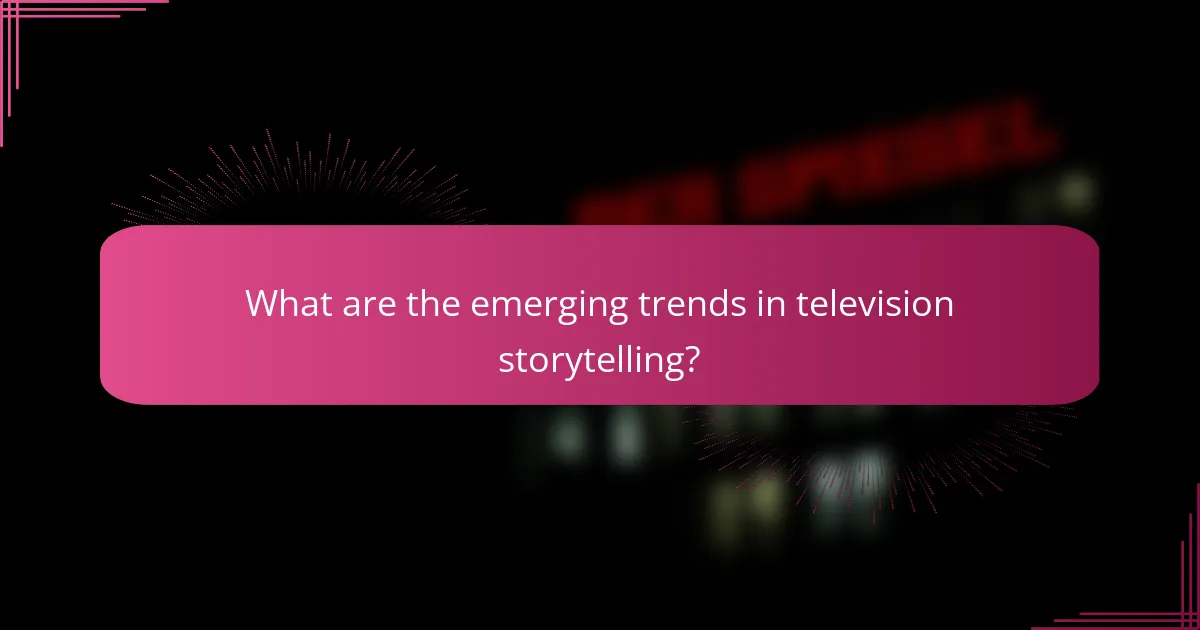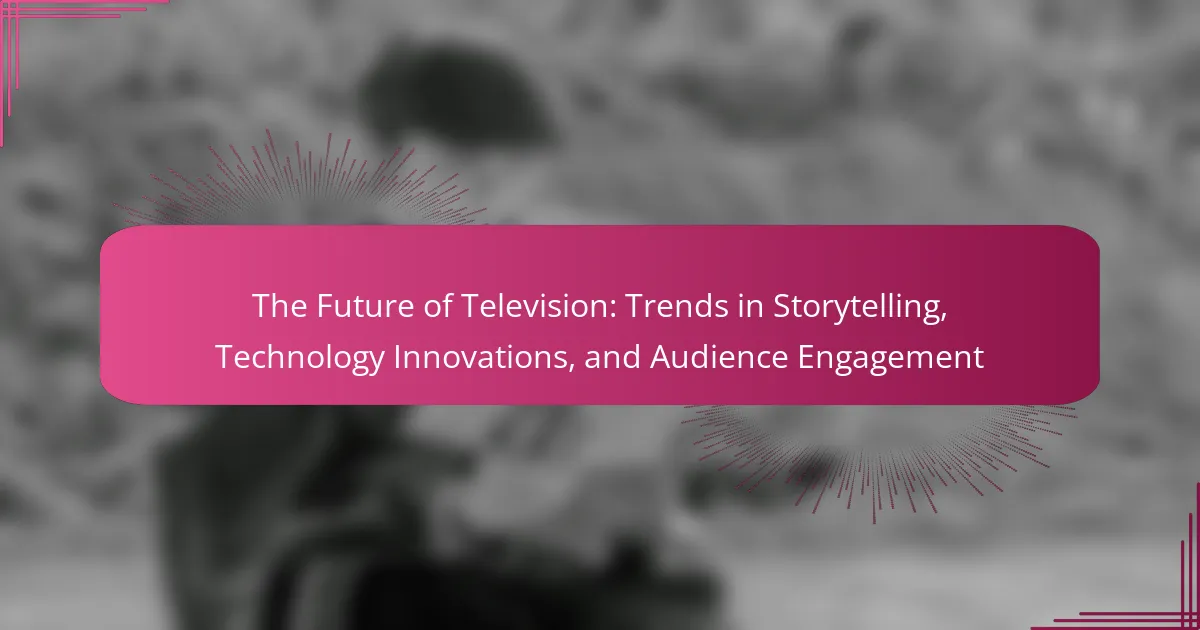The article explores the future of television through key trends in storytelling, technology innovations, and audience engagement. It highlights emerging storytelling trends such as interactive narratives, serialized formats, and diverse representation, which enhance viewer engagement and broaden cultural experiences. Technological advancements, including streaming services, high-resolution displays, and smart TVs, are transforming viewing habits and content accessibility. Furthermore, the evolution of audience engagement is marked by interactive content and multi-platform experiences, reflecting a shift towards greater viewer involvement and community-building in content creation. This comprehensive overview addresses how these elements are reshaping the television landscape.

What are the emerging trends in television storytelling?
Emerging trends in television storytelling include interactive narratives, serialized formats, and diverse representation. Interactive narratives allow viewers to influence plot outcomes, enhancing engagement. Serialized formats focus on long-term character development and intricate plots, drawing audiences to binge-watch. Diverse representation in storytelling reflects a broader range of experiences and cultures, appealing to wider audiences. Additionally, the use of non-linear storytelling techniques challenges traditional narrative structures. These trends are shaping how stories are told and consumed in the television landscape.
How are narratives evolving in the age of digital media?
Narratives are evolving in the age of digital media through increased interactivity and audience participation. Digital platforms allow viewers to engage with stories in real-time. This shift enables creators to incorporate user-generated content into narratives. Social media facilitates discussions, allowing audiences to influence storylines. Streaming services offer binge-watching options, changing how stories are consumed. Data analytics help tailor narratives to audience preferences. Virtual and augmented reality provide immersive storytelling experiences. These advancements reflect a move towards personalized and participatory storytelling.
What role does audience interactivity play in storytelling?
Audience interactivity enhances storytelling by engaging viewers actively in the narrative. It allows the audience to influence plot developments and character decisions. This participation fosters a deeper emotional connection with the story. Research indicates that interactive storytelling can increase viewer retention rates. For instance, a study by the University of Southern California found that interactive elements can boost audience engagement by 40%. Furthermore, interactivity can create personalized experiences, making stories more relevant to individual viewers. Overall, audience interactivity transforms passive viewers into active participants, enriching the storytelling experience.
How are streaming platforms influencing narrative structures?
Streaming platforms are significantly influencing narrative structures by promoting binge-watching and serialized storytelling. These platforms often release entire seasons at once, allowing viewers to consume content at their own pace. This shift encourages creators to develop more complex, multi-layered narratives that can unfold over several episodes. Traditional episodic formats are being replaced by longer arcs that maintain viewer engagement over time.
Furthermore, streaming platforms facilitate diverse storytelling techniques such as nonlinear narratives and multiple perspectives. Data from a 2020 Nielsen report indicates that 70% of viewers prefer shows with intricate plots that require sustained attention. This preference drives writers to create richer character development and intricate storylines.
Additionally, algorithms used by streaming services analyze viewer preferences, influencing the types of stories produced. This data-driven approach leads to tailored narratives that resonate with specific audiences. As a result, streaming platforms are reshaping how stories are told and experienced in modern television.
What are the key themes shaping contemporary television narratives?
Key themes shaping contemporary television narratives include diversity, mental health, and social justice. Diversity in casting and storytelling reflects broader societal changes. Many shows now feature underrepresented voices and experiences. Mental health is increasingly portrayed in a nuanced manner, addressing stigmas and promoting understanding. Social justice themes resonate through narratives that challenge systemic issues. These themes are evident in popular series like “This Is Us” and “The Handmaid’s Tale.” They engage viewers by fostering empathy and sparking conversations. Research indicates that audiences are drawn to content that reflects their realities and values.
How do cultural shifts impact the stories being told?
Cultural shifts significantly impact the stories being told by altering themes, character representation, and narrative structures. These changes reflect evolving societal values and norms. For instance, the rise of social movements has led to more diverse characters and perspectives in storytelling. Studies show that increased representation can enhance audience engagement and relatability. A report by the Geena Davis Institute on Gender in Media highlights that films with diverse casts perform better at the box office. Additionally, cultural shifts can influence genre popularity, as seen with the surge in demand for content addressing social issues. This evolution in storytelling resonates with contemporary audiences, making narratives more relevant and impactful.
What genres are gaining popularity and why?
Drama and fantasy genres are gaining popularity due to their immersive storytelling. Viewers seek deeper emotional connections and escapism. Streaming platforms have increased accessibility to diverse content. Data shows that fantasy series like “The Witcher” and dramas such as “Succession” have significant viewership growth. The rise of binge-watching culture also enhances genre appeal. Audiences enjoy serialized storytelling that builds tension over multiple episodes. Additionally, the influence of social media boosts genre visibility and discussion. This trend indicates a shift towards complex narratives and character-driven plots.

What technological innovations are transforming television?
Technological innovations transforming television include streaming services, 4K and 8K resolution, and smart TVs. Streaming services like Netflix and Hulu have changed viewing habits significantly. They offer on-demand content, allowing viewers to watch shows anytime. 4K and 8K resolutions provide enhanced picture quality, improving the viewing experience. Smart TVs integrate internet connectivity and apps, enabling access to various content platforms. Artificial intelligence is also personalizing recommendations for viewers. Virtual and augmented reality are creating immersive experiences in storytelling. These innovations collectively shape how audiences engage with television content today.
How is artificial intelligence being integrated into television production?
Artificial intelligence is being integrated into television production through various applications. AI is used for script analysis to predict viewer preferences and enhance storytelling. It automates editing processes, reducing time and costs significantly. AI-driven tools assist in visual effects and animation, improving quality and efficiency. Additionally, AI algorithms analyze audience data to personalize content recommendations. This integration enhances viewer engagement and satisfaction. A report by PwC states that AI could boost productivity in media by 30% by 2030.
What are the implications of AI on scriptwriting and editing?
AI significantly impacts scriptwriting and editing by enhancing efficiency and creativity. It automates repetitive tasks, allowing writers to focus on storytelling. AI tools can analyze audience preferences and suggest plot developments. They also assist in generating dialogue and character arcs based on existing scripts. For editing, AI can identify inconsistencies and improve pacing. Studies show AI can reduce script development time by up to 30%. This integration fosters innovative storytelling techniques and personalized content.
How does AI enhance viewer personalization?
AI enhances viewer personalization by analyzing individual preferences and behaviors. It utilizes algorithms to curate content tailored to each viewer’s tastes. For example, streaming platforms like Netflix employ AI to recommend shows based on viewing history. According to a 2021 report by McKinsey, personalized recommendations can increase viewer engagement by up to 80%. AI also adapts in real-time, learning from new interactions to refine suggestions. This dynamic approach ensures that the content remains relevant to the viewer. Additionally, AI can analyze demographic data to enhance user experience further. Overall, AI’s ability to process vast amounts of data leads to more meaningful and engaging viewing experiences.
What advancements in broadcasting technology are on the horizon?
Advancements in broadcasting technology on the horizon include 5G integration and enhanced streaming capabilities. 5G technology will allow for faster data transmission and lower latency. This will significantly improve live broadcasting and real-time interaction with audiences. Additionally, advancements in artificial intelligence will enable personalized content recommendations. AI can analyze viewer preferences to tailor programming. Furthermore, virtual and augmented reality are set to transform viewer experiences. These technologies will create immersive environments for storytelling. Blockchain technology may also enhance content distribution and rights management. This will ensure transparency and security in broadcasting. Overall, these advancements will reshape how content is created and consumed.
How will 8K resolution change the viewing experience?
8K resolution will significantly enhance the viewing experience by providing four times the pixel density of 4K resolution. This increase in pixel density results in sharper and more detailed images. Viewers will notice finer details in textures and backgrounds that were previously indistinguishable. The immersive quality of 8K makes large screen displays more effective, as viewers can sit closer without seeing pixelation.
Furthermore, 8K content allows for a more lifelike representation of scenes, improving the overall realism. The increased clarity can enhance color accuracy and contrast, leading to a more vibrant picture. According to a study by the International Telecommunication Union, higher resolutions correlate with improved viewer satisfaction. This suggests that 8K will likely transform how audiences engage with visual content.
What is the potential of virtual and augmented reality in storytelling?
Virtual and augmented reality have significant potential in storytelling. They create immersive experiences that engage audiences in unique ways. Users can interact with narratives, making them active participants. This interactivity enhances emotional connections to the story. Studies show that immersive storytelling can increase retention and understanding of content. For example, a 2020 study by the University of Southern California found that VR experiences can lead to a 30% increase in empathy towards characters. Augmented reality can overlay digital elements onto the real world, enriching storytelling contexts. This technology allows for innovative ways to blend fiction with reality. Overall, virtual and augmented reality can transform traditional storytelling into dynamic, engaging experiences.

How is audience engagement evolving in the television landscape?
Audience engagement in the television landscape is evolving through interactive content and multi-platform experiences. Traditional viewing habits are shifting as audiences seek more involvement. Streaming services are introducing features like live polls and social media integration. This allows viewers to influence story outcomes in real-time. According to a 2022 Nielsen report, 70% of viewers prefer shows that offer interactive elements. Additionally, platforms like Twitch have popularized live streaming and audience participation. This trend is reshaping how content creators approach storytelling. Engaging audiences through community-building is becoming essential for success.
What strategies are networks using to enhance viewer interaction?
Networks are using interactive technology to enhance viewer interaction. They implement real-time polling during broadcasts. This allows viewers to express opinions instantly. Many networks also utilize social media integration. Viewers can engage with content through platforms like Twitter and Instagram. Live chats and Q&A sessions are becoming common during shows. This fosters a sense of community among viewers. Additionally, personalized content recommendations are offered based on viewer preferences. Data analytics play a crucial role in tailoring these suggestions. These strategies collectively aim to create a more engaging viewing experience.
How do social media platforms influence audience engagement?
Social media platforms significantly influence audience engagement by facilitating real-time interaction. They enable users to comment, share, and react to content instantly. This immediate feedback loop increases viewer involvement and creates a sense of community. According to a study by Statista, 54% of social media users engage with brands through comments and likes. Additionally, platforms use algorithms to promote content that resonates with users, enhancing visibility. This targeted approach leads to higher engagement rates. For instance, Facebook’s algorithm prioritizes posts with high interaction, ensuring that engaging content reaches more users. Overall, social media platforms are crucial in shaping how audiences interact with content.
What role does feedback play in shaping future content?
Feedback plays a crucial role in shaping future content. It provides insights into audience preferences and engagement levels. By analyzing feedback, creators can identify what resonates with viewers. This information allows for adjustments in storytelling techniques and content delivery. Additionally, feedback can highlight areas needing improvement or innovation. For example, viewer ratings and comments can guide the development of new episodes. Data from platforms like social media can reveal trends in audience behavior. Ultimately, incorporating feedback leads to more relevant and compelling content.
How are viewing habits changing among different demographics?
Viewing habits are changing significantly among different demographics. Younger audiences are increasingly favoring streaming services over traditional cable. According to a 2022 report by Nielsen, 61% of 18- to 34-year-olds primarily watch streaming content. In contrast, older demographics, such as those aged 50 and above, still prefer cable television, although their streaming usage is rising. The same report indicates that 30% of this age group now uses streaming platforms regularly. Additionally, viewing times are shifting. Younger viewers often watch content on mobile devices, while older viewers tend to watch on larger screens. This generational divide highlights a trend towards on-demand viewing among younger audiences, while older viewers maintain a more scheduled viewing pattern. Overall, these changes reflect broader technological advancements and evolving preferences in content consumption.
What trends are emerging in binge-watching behavior?
Emerging trends in binge-watching behavior include increased viewership of shorter series and a rise in mobile streaming. Viewers are gravitating towards limited series that offer concise storytelling. According to a report by Nielsen, 70% of streaming viewers prefer shows with fewer episodes. Additionally, mobile streaming has surged, with 60% of users watching content on smartphones while commuting. The use of social media to discuss shows has also intensified, enhancing community engagement. These trends indicate a shift towards more flexible and interactive viewing experiences.
How do younger audiences consume television content differently?
Younger audiences consume television content differently by primarily using streaming services instead of traditional cable. They prefer on-demand viewing, allowing them to watch shows at their convenience. This demographic often engages with content through mobile devices. According to a 2022 survey by Nielsen, 60% of Gen Z and millennials favor streaming platforms. Social media also plays a significant role in their viewing habits. They often discover new shows through platforms like TikTok and Instagram. Binge-watching is a common practice among younger viewers, with many completing series in a single sitting. This shift in consumption reflects changing preferences towards flexibility and interactivity in media.
What best practices can networks adopt to improve audience engagement?
Networks can improve audience engagement by utilizing data analytics to understand viewer preferences. Data-driven insights allow networks to tailor content to specific audience segments. Personalized recommendations based on viewing history enhance viewer satisfaction. Interactive content, such as polls and live Q&A sessions, fosters real-time audience participation. Social media integration encourages audience discussions and community building around shows. Consistent communication through newsletters and updates keeps audiences informed and connected. High-quality production values attract and retain viewers’ attention. Lastly, leveraging user-generated content can create a sense of ownership and involvement among the audience.
How can data analytics inform content creation strategies?
Data analytics can significantly inform content creation strategies by providing insights into audience preferences and behaviors. By analyzing viewer data, content creators can identify trending topics and genres that resonate with specific demographics. This targeted approach ensures that content aligns with audience interests, increasing engagement and viewership. Analytics can also reveal optimal content formats and lengths for different platforms. For instance, data may show that younger audiences prefer shorter, more dynamic content. Additionally, performance metrics from previous content help refine future strategies. By assessing what worked and what did not, creators can make informed decisions that enhance storytelling and audience connection.
What are effective methods for fostering community among viewers?
Effective methods for fostering community among viewers include interactive content and social media engagement. Interactive content encourages participation through polls, quizzes, and live chats. This creates a sense of involvement and belonging among viewers. Social media platforms allow viewers to connect and share their thoughts in real-time. Regularly scheduled live events can enhance viewer interaction. These events foster discussions and strengthen relationships. Additionally, creating dedicated online forums can provide a space for deeper conversations. This helps build a loyal community around shared interests. According to research by the Pew Research Center, 69% of adults use social media to connect with others, highlighting its role in community building.
The main entity of the article is the evolving landscape of television, focusing on trends in storytelling, technological innovations, and audience engagement. Key trends include interactive narratives, serialized formats, and diverse representation, which enhance viewer engagement and reflect societal changes. The article examines how digital media and streaming platforms influence narrative structures, while also exploring the impact of artificial intelligence and data analytics on content creation and personalization. Additionally, it addresses changing viewing habits among different demographics and offers strategies for networks to improve audience interaction and foster community.
